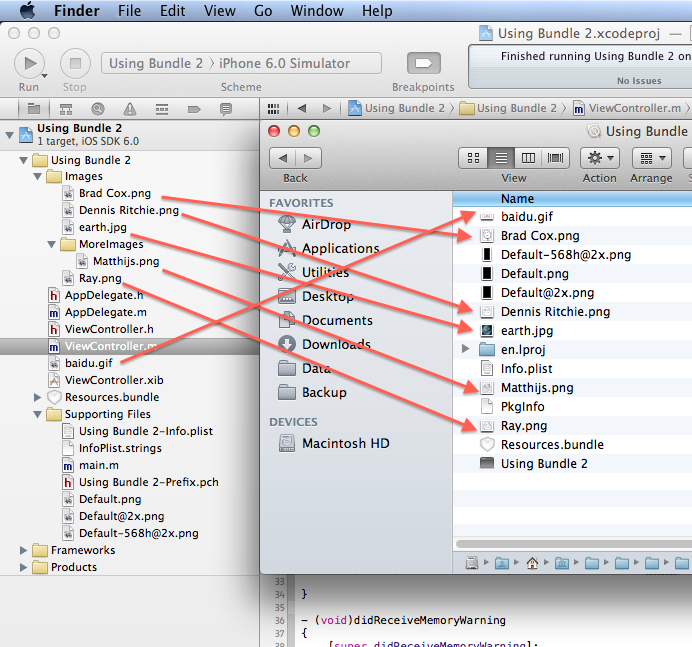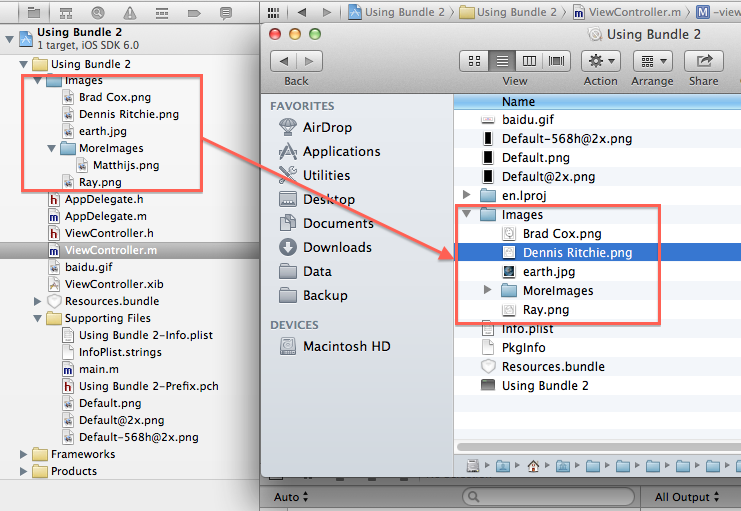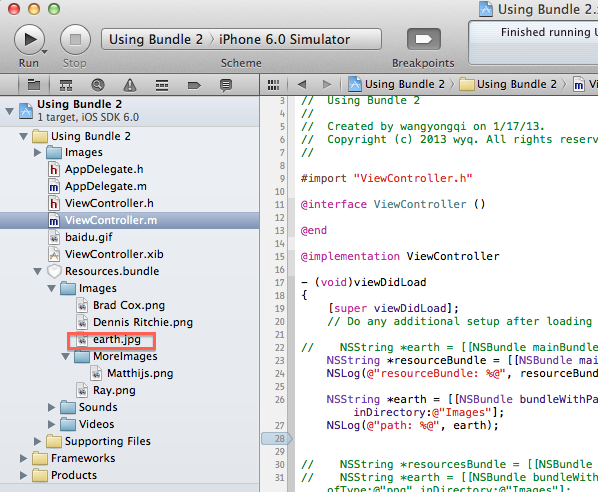1、[NSBundle mainBundle],文件夹其实是Group,如左侧的树形文件管理器

Build之后,文件直接就复制到了根目录下,于是读取的方法,应该是这样:
NSString *earth = [[NSBundle mainBundle] pathForResource:@"Brad Cox" ofType:@"png"]; |
2、使用文件夹的时候,Build结果

依然使用同样的方法,不需要制定文件夹路径
//inDirectory参数可有可无
NSString *earth = [[NSBundle mainBundle] pathForResource:@"Matthijs" ofType:@"png" inDirectory:@"Images/MoreImages"]; NSString *earth = [[NSBundle mainBundle] pathForResource:@"Matthijs" ofType:@"png"];
编译之后,mainBundle的资源都是放到RootFolder下,所以,可以直接访问,不要指定内部路径
3、使用其他的Bundle

NSString *resourceBundle = [[NSBundle mainBundle] pathForResource:@"Resources" ofType:@"bundle"]; NSLog(@"resourceBundle: %@", resourceBundle); NSString *earth = [[NSBundlebundleWithPath:resourceBundle] pathForResource:@"Matthijs"ofType:@"jpg"inDirectory:@"Images/MoreImages"]; NSLog(@"path: %@", earth); |
使用Custom bundle,访问内部的子文件夹,需要指定inDirectory参数,这个mainBundle不同,这是为何?
注意:Sincebundles other than the main bundle can have folders embedded inside them, to accessfiles inside folders of a bundle other than the main bundle it is best to use the pathForResource:ofType:inDirectory: method of NSBundle to explicitly specify the folder inwhich a specific file/resource exists. |
原文链接:http://www.cnblogs.com/iihe602/archive/2013/01/17/2865280.html
其他一些NSBundle函数的使用
1.获取app的info.plist详细信息
版本号:Bundle version
NSString *version = [[[NSBundle mainBundle] infoDictionary] objectForKey:@"CFBundleVersion"];
应用标识:Bundle identifier
NSString *bundleId = [[[NSBundle mainBundle] infoDictionary] objectForKey:@"CFBundleIdentifier"];
应用名称:Bundle display name
NSString *appName = [[NSBundle mainBundle] objectForInfoDictionaryKey:@"CFBundleDisplayName"];
Bundle name
NSString *appName = [[NSBundle mainBundle] objectForInfoDictionaryKey:@"CFBundleName"];
2.应用程序语言本地化
app本地化宏
#define XLocalizedString(key, comment) [[NSBundle mainBundle] localizedStringForKey:(key) value:@"" table:nil]
中英文两个Localizable.strings文件中键值对,例如
"none" = "确定";
"none" = "none";
宏的用法:(返回NSString *)
localizedString("none", "这是注释")
3.获取包内文件路径和文件
获取app包路径
NSString *path = [[NSBundle mainBundle] bundlePath];
app资源目录路径
NSString *resPath = [[NSBundle mainBundle] resourcePath];
获取资源目录下a.bundle
NSString* path = [resPath stringByAppendingPathComponent:@"a.bundle"]; NSBundle *bundle = [NSBundle bundleWithPath:path];
获取app包的readme.txt文件路径
NSString *path = [[NSBundle mainBundle] pathForResource:@"readme" ofType:@"txt"];






 浙公网安备 33010602011771号
浙公网安备 33010602011771号